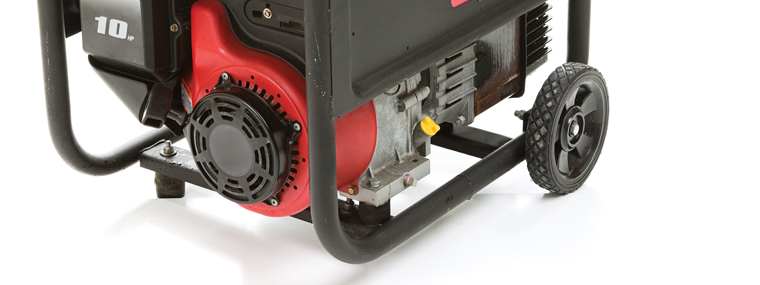
Why Use Generators?
By Diane M. Calabrese / Published April 2017

A generator transforms mechanical energy into electrical energy. The Hoover Dam is a generator (hydro-electric) on the very large side of the spectrum. On the smaller side are the generators that provide a steady, even flow of current that allow motors to start and operate.
Early on, a generator was called a dynamo (from the Greek for dynamic or dynamism). Today, large generators, such as Hoover Dam’s hydro-plant, produce the electric current that heads to transmission lines.
Michael Faraday (1791–1867) formalized concepts of magnetic induction and transformation of mechanical energy into electrical energy. Yet long before that, keen observers recognized metallic conductors like copper and iron and non-metallic conductors like solutions of salts, acids, and alkalis in water. Non-conductors such as rubber got noticed too.
By the beginning of the 20th century, the usefulness of electricity had everyone’s attention. As the U.S. grid began to grow, those still beyond its reach improvised in order to take advantage of electric lights and refrigeration. Farmers used gasoline-driven and tractor engine-driven generators to create a usable electric current. They also converted water wheels and windmills, which had been direct sources of mechanical power for tools like saws, to generators of the electricity capable of powering more exacting tools.
Electric current flow may be direct (DC), with electrons flowing in one direction, or in a loop; or it may be alternating (AC) with a flow in one direction and then a flow in the other direction around the loop. In the United States, there are 60 back-and-forth cycles per second, so our AC current is measured at 60 hertz (3600 cycles per minute), with hertz being the frequency measure. In Europe and much of the rest of the world, the back and forth of current in a loop is 50 hertz (3000 cycles per minute).
It’s always good to keep Ohm’s law in mind when discussing any aspect of electricity. It is Current = Voltage/Resistance. Voltage is the force driving electrons along (loosely analogous to water pressure, but only loosely because differences in electric potential are the driver).
The less resistance voltage meets, as in the thicker a wire available for the electrons to flow through, the greater the current (flow). An ohm is the unit of measure for resistance. An ampere is the unit of measure for current. Finally, we get to the watt, our measure of power. A watt is equal to the voltage multiplied by the current.
One hundred volts meeting a resistance of 50 ohms results in a current of two amperes. The 100 volts and two amperes (100×2) give us 200 watts of power. (We are going to simplify and skip over three (overlapping) phases of AC flow, which ultimately allow for more efficient use of transmission lines and more reliable flow to circuits to operate more loads. While industrial equipment runs on three-phase, single-phase equipment is the norm in residential settings.
Every bit of the foregoing is a simplification, of course. Hoover Dam, for example, generates electricity through a system more complex than water striking a turbine and causing it to spin and turn a shaft that rotates magnets past copper coils, producing electricity. But that’s the essence of what happens: turbine, shaft, stator (coil of copper wire, stationary), rotor (series of electromagnets that rotates with shaft), and exciter (actually a generator itself, and its purpose is to charge the magnetic field of a rotor).
Small generators incorporate the same elements as the large Hoover Dam. They do so even though in many of them it is internal combustion that powers the generation of electricity. WINCO, a manufacturer of generators based in Le Center, MN, uses the term ‘prime mover’ to describe the engine or other input power source that drives the generator.
Ambient temperature, altitude, fuel, and other conditions can affect the generator itself and the prime mover. Read the manufacturer’s recommendations on dealing with the variables and follow all instructions.
Finally, four words we should add to the generator lexicon here are bushing, armature, winding, and brushes. A bushing is a cylindrical metal sleeve inserted into a machine part for reducing the effect of friction on moving parts, providing insulation. An armature consists of a long-loop wire, a winding (electric coil); as it rotates between magnetized poles, a current of electricity moves through it. Brushes convey current from the armature to an external circuit.
Why Generators?
Generators play many roles in our industry. One is to augment the power supply at a particular location.
“Our dealers will set up mobile trailers based on the contract cleaner’s requirements,” says Karl Loeffelholz, dealer division manager at Mi-T-M Corporation in Peosta, IA. “If the mobile contract cleaner requires additional equipment to operate items such as lighting or a recovery vacuum, he will install a generator to operate these items.”
There is another common role that generators take. “They are mostly used to provide 110-volt power supply to operate the burner assembly on gasoline or diesel powered hot water pressure washers,” says Dr. Marlo Dean, senior support services manager at Kärcher North America in Camas, WA.
Q&A Generators
We put a few questions about generators, especially how they are best understood, to Dr. Dean. Here are those questions and responses:
Cleaner Times (CT): Are you satisfied with the lay concept of an electrical generator as a device that converts mechanical energy into electrical energy, working somewhat in reverse of an electric motor? Or, would you choose a different (better) way to distinguish the two devices?
Dean: In a generator, the shaft attached to the rotor is driven by a mechanical force and electrical current is produced in the armature windings, while the shaft of a motor is driven by the magnetic forces developed between the armature and field; current has to be supplied to the armature winding.
CT: Is there one part of routine maintenance that is too often neglected when aiming to ensure health and longevity of an electrical generator?
Dean: You need to have enough power and rpm to operate a generator. If the operator throttles down the engine, you drop voltage and increase amperage, which can cause damage to components. If you attempt to operate an electrical product that requires more watts than the generator or engine can provide, you will also damage the generator and electrical components.
CT: What do you consider to be the greatest innovation in electrical generators across the last several years?
Dean: Generators in the past used AC brush design. The newer design changed to solid state voltage regulators called brushless. In the case of brushed versus brushless, the main difference is price of materials. With brushed, you only have two sets of windings, where in brushless you have four windings. Most brushed generators are self-regulating in design. In brushed you have slip rings and brush, brush holders, etc. In brushless you have diodes, more windings, and an AVR [auto voltage regulator]. Brushless would seem to need less maintenance, but it is more complicated; and when or if it breaks, it requires more experience and parts to fix the problem. There are different opinions, but our experience in using both over several years is that the brushed generators have a tendency to last longer in our applications.
CT: What accounts for the high decibel level of many electrical generators? Can that level be reduced by changes to design?
Dean: We do not see any noticeable decibel levels in the generators we use on pressure washers. You may be thinking about a complete generator set, which includes an engine [the pair is sometimes called a ‘genset’]. We use the engine that drives the pressure washer pump to also drive the generator. The generator by itself does not create a noticeable level of sound.
Safety
Using portable generators successfully and safely requires strict adherence to the recommendations of their manufacturers and to advisories of safety regulators.
OSHA reminds users of portable generators that there are three major causes of injuries and fatalities: shocks and electrocution from improper use of power or accidentally energizing other electrical systems; carbon monoxide from the exhaust; and fires from improper fueling or inappropriate storage of fuels.
Safe work practices when using generators begin with following all use parameters and maintenance requirements of the manufacturer and follow through to adhering to all safe work practices established by OSHA. Fuel lines should be inspected before each use and after moving or handling. Generators should be kept dry. Shut down a generator before refueling.
A generator should never be connected to a structure that is connected to the grid unless the structure is equipped with the proper transfer switch (approved by the local utility). An improper connection could lead to electrocution of a utility worker.
Use cords recommended by or supplied by the manufacturer of a generator for connections to equipment. Use GFCIs (ground-fault circuit interrupters) as required. Only qualified electrical technicians should perform service on generators.





